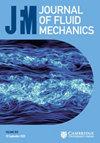水下床面开裂
IF 3.9
2区 工程技术
Q1 MECHANICS
引用次数: 0
摘要
我们研究了在许多自然、地球物理和工业应用中出现的弹丸撞击水下床面所造成的弹坑形成和气体释放现象。我们实验中的水床由疏水颗粒构成,在水床孔隙中截留了大量空气。与干床不同的是,浸没床中的空气-水界面会产生颗粒表皮,通过在主体上产生表皮来为介质提供刚度。弹丸的能量被用来重组颗粒,从而导致表皮破裂,使滞留的空气得以排出。在浸没床中,火山口的形态与冲击能量的函数关系呈现出不同于干床的缩放规律。这种现象归因于浸没颗粒疏水分形表面上的接触线运动。释放的气体量是多种因素的函数,主要是弹丸的速度、床的深度和水体的深度。本文章由计算机程序翻译,如有差异,请以英文原文为准。
Cracking of submerged beds
We investigate the phenomena of crater formation and gas release caused by projectile impact on underwater beds, which occurs in many natural, geophysical and industrial applications. The bed in our experiment is constructed of hydrophobic particles, which trap a substantial amount of air in the pores of the bed. In contrast to dry beds, the air–water interface in a submerged bed generates a granular skin that provides rigidity to the medium by producing skin over the bulk. The projectile's energy is used to reorganize the grains, which causes the skin to crack, allowing the trapped air to escape. The morphology of the craters as a function of impact energy in submerged beds exhibits different scaling laws than what is known for dry beds. This phenomenon is attributed to the contact line motion on the hydrophobic fractal-like surface of submerged grains. The volume of the gas released is a function of multiple factors, chiefly the velocity of the projectile, depth of the bed and depth of the water column.
求助全文
通过发布文献求助,成功后即可免费获取论文全文。
去求助
来源期刊
CiteScore
6.50
自引率
27.00%
发文量
945
审稿时长
5.1 months
期刊介绍:
Journal of Fluid Mechanics is the leading international journal in the field and is essential reading for all those concerned with developments in fluid mechanics. It publishes authoritative articles covering theoretical, computational and experimental investigations of all aspects of the mechanics of fluids. Each issue contains papers on both the fundamental aspects of fluid mechanics, and their applications to other fields such as aeronautics, astrophysics, biology, chemical and mechanical engineering, hydraulics, meteorology, oceanography, geology, acoustics and combustion.

 求助内容:
求助内容: 应助结果提醒方式:
应助结果提醒方式:


